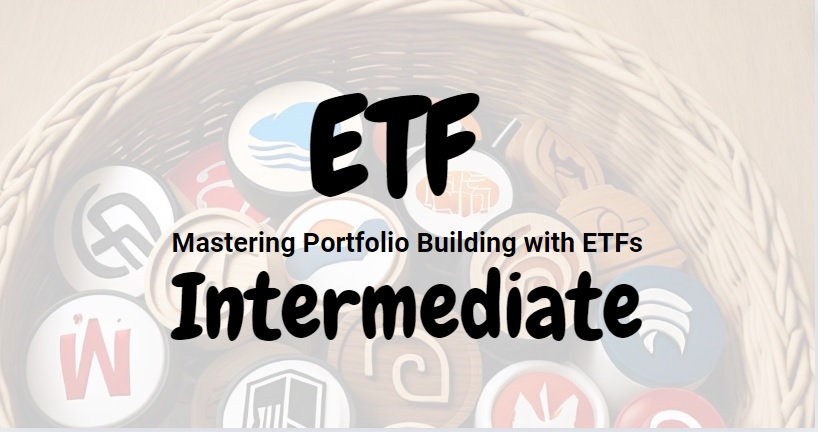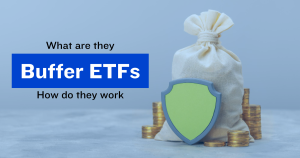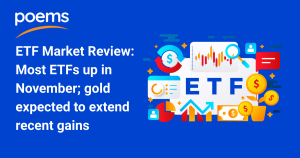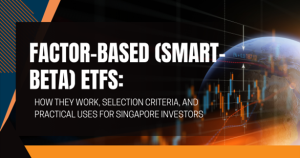ETF Intermediate: Mastering Portfolio Building with ETFs July 15, 2024

We hope you’ve gained a better understanding of the fundamentals of exchange-traded funds (ETFs) from our previous article. You know their structure, advantages, and why they are ideal for portfolio building.
For those who may not have had the chance to read it, here is a quick recap: ETFs are investment vehicles that hold a basket of securities, like mutual funds, but with key differences. They are traded on exchanges like stocks, offering diversification, low costs, and high liquidity. These characteristics make ETFs an attractive choice for portfolio building, providing flexibility, variety, and tax efficiency.
Now it’s time to take your knowledge to the next level. This guide will equip you with the tools and strategies needed to construct and manage a robust ETF portfolio tailored to your unique investment goals and risk tolerance.
Building an effective ETF portfolio begins with understanding your risk tolerance. Risk tolerance is a combination of your capacity and willingness to take on investment risk, influenced by factors such as your age, investment time horizon, financial goals, and emotional ability to withstand market fluctuations. To assess your risk tolerance, consider using risk profiling questionnaires or consulting with a financial advisor. This will help determine whether a conservative, moderate, or aggressive portfolio aligns best with your risk profile.
Here are 5 questions that could help determine a person’s risk profile:
- 1. If you had a 50% chance of doubling your investment but also a 50% chance of losing half of it, would you take that risk?
a) No
b) Maybe
c) Yes - 2.You inherit $100,000 today. Which of the following investments would you choose?
a) A savings account earning 2% interest
b) A diversified stock portfolio with moderate risk and return
c) A high-risk, high-return investment in a new technology startup - 3. You are 35 years old and just received a S$50,000 windfall unexpectedly. How would you invest it?
a) Put it all in a low-risk money market fund
b) Split it between stocks and bonds
c) Invest it all in an aggressive growth stock fund - 4. Your investment portfolio has lost 20% of its value in the past year due to market volatility. What would you do?
a) Sell all remaining holdings to avoid further losses
b) Hold steady and make no changes
c) Invest more money while prices are low - 5.You are nearing retirement age with a sizable nest egg. How would you invest your retirement savings?
a) Mostly in bonds and cash equivalents to preserve capital
b) A balanced mix of stocks and bonds
c) Primarily in growth stocks to continue building wealth
If most of your answers landed on “A”, then you might prefer a more conservative investment style. If they landed on “C”, it would likely mean you have a more aggressive preference towards investing, and more willing to accept higher volatility and potential loss.
Goal-Based Investing
In addition to your risk profile, your investment goals play a crucial role in shaping your ETF portfolio. Short-term goals such as saving for a house down payment may require a more conservative approach, while long-term goals like retirement planning may allow for a higher risk tolerance over time. Aligning your ETF selections with your time horizons through diversification strategies can help to optimise your portfolio’s risk-return profile. For instance, a longer time horizon may warrant a higher allocation to growth-oriented equity ETFs.
The Importance of Asset Classes
Diversification across asset classes is key to building a well-rounded ETF portfolio. Here’s a brief overview of major asset classes and their roles:
- Stocks offer growth potential but are more volatile. Equity ETFs can provide exposure to various markets, sectors, and investment styles (more examples below)
- Bonds provide income and stability but typically lower returns. Bond ETFs can range from government to corporate bonds with varying risk profiles.
- Commodities act as an inflation hedge but can be cyclical. Commodity ETFs offer exposure to precious metals, energy, and agricultural products.
Real Estate offers diversification and income potential through real estate investment trust (REIT) ETFsSo how can you start constructing your ETF portfolio? To begin, investors can use existing models as a starting point.
Strategic Allocation Models provide frameworks for constructing your ETF portfolio based on your risk tolerance and investment objectives. These include:
- Age-based Models: Shift allocations from an aggressive to conservative portfolio as you approach retirement age
- Risk-based Models: Align allocations with your risk tolerance, ranging from a conservative to aggressive portfolio
- Hybrid Models: Combine different approaches, such as age-based and risk-based models
Some Examples of Portfolio Construction Strategies with ETFs
| Core ETF | Broad-based, Core ETF (examples) |
| Total Stock Market ETF | Vanguard Total Stock Market Index Fund ETF (VTI) |
| S&P 500 Index ETF | Vanguard S&P 500 ETF (VOO) |
| Total Bond Market ETF | Vanguard Total Bond Market Index Fund ETF (BND) |
| Global Stock Market ETF | Vanguard Total World Stock ETF (VT) |
| Global Real Estate ETF | Vanguard Global ex-US Real Estate Index Fd ETF (VNQI) |
| Gold ETF | SPDR Gold Trust (GLD) |
| Dividend ETF | Vanguard High Dividend Yield ETF (VYM) |
| Multi-Asset Income ETF | RLY SPDR SSgA Multi-Asset Real Return ETF (RLY) |
| Satellite ETFs | Factor-Based ETFs (examples) |
| Value | Vanguard Value ETF (VTV) iShares MSCI USA Value Factor ETF (VLUE) |
| Growth | Vanguard Growth ETF (VUG) Schwab U.S. Large-Cap Growth ETF (SCHG) |
| Momentum | iShares MSCI USA Momentum Factor ETF (MTUM) Alpha Architect U.S. Quantitative Momentum ETF (QMOM) |
| Quality | iShares MSCI USA Quality Factor ETF (QUAL) SPDR MSCI USA Quality Mix ETF (QUS) |
| Low Volatility | Invesco S&P 500 Low Volatility ETF (SPLV) iShares Edge MSCI Min Vol USA ETF (USMV) |
| Multi-Factor | iShares Edge MSCI Multifactor USA ETF (LRGF) JPMorgan Diversified Return U.S. Equity ETF (JPUS) |
| Satellite ETFs | Sector ETFs (examples) |
| Technology | Technology Select Sector SPDR Fund (XLK) Vanguard Information Technology ETF (VGT) |
| Healthcare | Health Care Select Sector SPDR Fund (XLV) iShares U.S. Medical Devices ETF (IHI) |
| Financials | Financial Select Sector SPDR Fund (XLF) Vanguard Financials ETF (VFH) |
| Energy | Energy Select Sector SPDR Fund (XLE) iShares Global Energy ETF (IXC) |
| Consumer Discretionary | Consumer Discretionary Select Sector SPDR Fund (XLY) Vanguard Consumer Discretionary ETF (VCR) |
| Industrials | Industrial Select Sector SPDR Fund (XLI) Vanguard Industrials ETF (VIS) |
| Materials | Materials Select Sector SPDR Fund (XLB) Vanguard Materials ETF (VAW) |
| Consumer Staples | Consumer Staples Select Sector SPDR Fund (XLP) Vanguard Consumer Staples ETF (VDC) |
| Utilities | Utilities Select Sector SPDR Fund (XLU) Vanguard Utilities ETF (VPU) |
| Real Estate | Vanguard Real Estate ETF (VNQ) Schwab U.S. REIT ETF (SCHH) |
| Communication Services | Communication Services Select Sector SPDR Fund (XLC) Vanguard Communication Services ETF (VOX) |
| Satellite ETFs | Sub-Sector / Thematic ETFs (examples) |
| Innovative Technology | ARK Innovation ETF (ARKK) SPDR® FactSet Innovative Technology ETF (XITK) |
| Clean Energy | First Trust NASDAQ Clean Edge Green Energy Index Fund (QCLN) iShares Global Clean Energy ETF (ICLN) |
| E-commerce | Amplify Online Retail ETF (IBUY) |
| Cybersecurity | First Trust NASDAQ Cybersecurity ETF (CIBR) ETFMG Prime Cyber Security ETF (HACK) |
| Cloud Computing | First Trust Cloud Computing ETF (SKYY) WisdomTree Cloud Computing Fund (WCLD) |
| Genomics/Biotech | ARK Genomic Revolution ETF (ARKG) VanEck Vectors Biotech ETF (BBH) |
| Video Gaming/Esports | VanEck Vectors Video Gaming and eSports ETF (ESPO) Global X Video Games & Esports ETF (HERO) |
| Satellite ETFs | Country/Region ETFs (examples) |
| Developed Markets | Vanguard FTSE Developed Markets ETF (VEA) SPDR® Portfolio Developed Wld ex-US ETF (SPDW) |
| Emerging Markets | iShares Core MSCI Emerging Markets ETF (IEMG) iShares MSCI Emerging Markets ETF (EEM) |
| Europe | Vanguard FTSE Europe ETF (VGK) iShares MSCI Europe ETF (IEUR) |
| Japan | iShares MSCI Japan ETF (EWJ) WisdomTree Japan Hedged Equity Fund (DXJ) |
| China | iShares MSCI China ETF (MCHI) WisdomTree China ex-State-Owned Enterprises Fund (CXSE) |
| India | iShares MSCI India ETF (INDA) iShares India 50 ETF (INDY) |
ETF Selection Criteria
When building or adjusting your ETF portfolio, it’s essential to carefully evaluate and compare the available options to ensure you select the most suitable ETFs for your investment goals and risk profile. Here are some critical criteria to consider:
- Analysing Expense Ratios: Expense ratios represent the annual fees charged by an ETF to cover its operating expenses. Lower expense ratios are generally preferable as they can have a significant impact on long-term returns due to compounding effects. Therefore, it’s vital to compare expense ratios across similar ETFs tracking the same or comparable indices. While lower ratios are better, don’t sacrifice quality or liquidity for minor fee differences. Lastly do not forget to consider the potential for tracking error and tax efficiency when evaluating expenses.
- Evaluating Liquidity and Trading Volume: Liquidity and trading volume are essential factors to consider, especially for active traders or those planning to execute large trades. Higher liquidity and trading volume can lead to tighter bid-ask spreads and more efficient trade execution. Review the average daily trading volume and bid-ask spreads of potential ETFs to ensure sufficient liquidity to accommodate your intended trade sizes. Highly liquid ETFs may be preferable for active trading strategies to reduce overall trading costs.
- Assessing Fund Management and Tracking Error: While most ETFs are designed to track an underlying index, some may employ active management strategies or use sampling techniques, which can lead to tracking errors. Understand the fund’s management approach whether it is passive indexing, active management, or based on another strategy. Review the historical tracking error and performance relative to the stated benchmark to evaluate potential impact on your investment objectives.
- Comparing Underlying Indices: The underlying index is a crucial factor in determining an ETF’s performance and exposure. It’s essential to understand the index methodology, constituents, and rebalancing rules. Evaluate the index construction methodology, align with your investment goals and compare factors like asset under management (AUM), top holdings weightage, sector weightings, geographic exposure and more. In addition to these criteria, you may also want to consider factors such as the ETF provider’s reputation, the fund’s assets under management, and any unique features or strategies employed by the ETF.
Rebalancing
Over time, your portfolio’s asset allocation can drift from its intended targets due to varying performance across asset classes. Rebalancing involves periodically adjusting your holdings to restore your desired allocation. Rebalancing strategies include:
- Time-based: Rebalancing at regular intervals (e.g., quarterly or annually)
- Threshold-based: Rebalancing when allocations deviate significantly from targets (e.g., 5% or 10% deviation)
Tax Considerations for Non-US Citizens Holding Dividend ETFs
Dividend Withholding Taxes: Many countries impose withholding taxes on dividends paid by foreign companies or ETFs. The withholding tax rates may vary based on the investor’s country of residence and any applicable tax treaties. Some countries provide relief or reduced withholding rates for dividends received through ETFs.
- Generally, US-listed ETFs come with a 30% dividend withholding tax
- To simplify planning, investors can consider ETF listed on SGX or HKEX for Dividend Plays.
Building Sample ETF Portfolios
Conservative Portfolio
A conservative portfolio is suitable for investors with a low risk tolerance, prioritising capital preservation overgrowth potential. The emphasis is on fixed income, dividend-paying stocks, and low volatility strategies. An example of allocation is as follows:
- 40% Total Bond Market ETF (e.g., BND, IUSB)
- 25% Dividend ETF (e.g., VYM, SCHD)
- 15% Low Volatility Equity ETF (e.g., SPLV, USMV)
- 10% Short-Term Treasury ETF (e.g., SHY, VGSH)
This portfolio aims to generate income while minimising volatility. The bond allocation provides stability, while dividend and low volatility equity ETFs offer modest growth potential with lower risk.
Moderate Portfolio
A moderate portfolio strikes a balance between growth and income and is suitable for investors with a moderate risk tolerance. It combines stocks and bonds, with some exposure to alternative asset classes. An example of allocation is as follows:
- 35% Total Stock Market ETF (e.g. VTI, ITOT)
- 25% Total Bond Market ETF (e.g. BND, IUSB)
- 10% International Equity ETF (e.g. IEFA, VXUS)
- 10% REIT ETF (e.g. CLR, CFA)
- 10% Dividend ETF (e.g. 3116, BIZD)
- 5% Commodity ETF (e.g. DBC, GSG)
- 5% Cash/Money Market (e.g. MMS / MMT)
This portfolio aims to capture long-term growth from stocks while generating income from bonds and dividend-paying equities. The inclusion of REITs and commodities adds diversification and potential inflation protection.
Aggressive Portfolio
An aggressive portfolio is suitable for investors with a high-risk tolerance and a long investment horizon. It emphasises growth potential through a higher allocation to stocks, including growth and international exposures. An example of allocation is as follows:
- 40% Total Stock Market ETF (e.g. VTI, ITOT)
- 20% International Equity ETF (e.g. IEFA, VXUS)
- 15% Growth ETF (e.g. VUG, SCHG)
- 10% Small-Cap ETF (e.g. IJR, SCHA)
- 5% Emerging Markets ETF (e.g. IEMG, EEM)
- 5% Technology Sector ETF (e.g. XLK, VGT)
This portfolio prioritises capital appreciation by overweighting equities, particularly in growth-oriented and international markets. The small-cap and sector ETFs provide additional growth potential, albeit with higher volatility.
Customising to Individual Needs
While these sample portfolios provide a general framework, it’s essential to customise your ETF portfolio based on your personal circumstances, goals, and risk preferences. Factors such as your age, investment time horizon, income needs, and tax considerations should be considered. Additionally, regular rebalancing and adjustments may be necessary to maintain your desired asset allocation and risk profile as market conditions and your personal situation evolve over time.
Performance Evaluation and Monitoring
Regularly evaluating and monitoring the performance of your ETF portfolio is crucial to ensure it is meeting your investment objectives and risk tolerance. Here are some key considerations:
- Risk Management Techniques:Effective risk management is essential for long-term success in investing. By employing various risk management techniques, you can potentially mitigate portfolio volatility, limit downside risk, and enhance overall returns. Here are some strategies to consider:
- Diversifying Across Factors and Investment Strategies:Diversification is a fundamental risk management principle. By diversifying your portfolio across different factors (e.g. value, momentum, quality) and investment strategies (e.g. active, passive, smart beta), you can reduce concentration risk and potentially enhance risk-adjusted returns. Combine factor-based ETFs targeting different risk premia (value, size, quality, etc.). Include both passive index-tracking ETFs and actively managed or smart beta ETFs. Additionally, diversify across asset classes, sectors, and geographic regions.
- Dynamic Asset Allocation Based on Market Conditions:Rather than maintaining a static asset allocation, consider adjusting your portfolio’s exposures based on changing market conditions and economic regimes. This can help you capitalise on opportunities and potentially reduce risk during periods of heightened volatility. Employ tactical asset allocation strategies by overweighting or underweighting certain asset classes or sectors based on market conditions. Investors can also use trend-following or momentum-based strategies to adjust exposures dynamically. Lastly, consider employing risk-based models that adjust allocations based on market risk levels.
- Incorporating Low-Volatility and Minimum Volatility ETFs:Low-volatility and minimum volatility ETFs are designed to provide exposure to stocks with lower historical volatility or risk characteristics. By allocating a portion of your equity exposure to low-volatility or minimum volatility ETFs, these ETFs can become a defensive component in your portfolio during periods of market stress and reduce overall portfolio volatility and downside risk. However, investors should evaluate the potential trade-off between lower volatility and potentially lower returns over the long term and choose one that best suits their needs.
- Use of Stop-Loss Orders and Hedging Strategies
Stop-loss orders and hedging strategies can help you manage risk by limiting potential losses or protecting against adverse market movements. Implement stop-loss orders to automatically sell positions if they decline beyond a predetermined level to minimise losses. In addition, consider hedging strategies , such as buying put options or inverse ETFs to protect against potential market downturns. But evaluate the costs and potential opportunity costs associated with such hedging strategies as they might impact investment returns.
How do you know if your portfolio management effort paid off?
Key Performance Metrics
- Alphameasures the risk-adjusted performance of your portfolio compared to a benchmark index. A positive alpha indicates that your portfolio is outperforming the benchmark on a risk-adjusted basis.
- Beta measures the volatility of your portfolio relative to the benchmark. A beta of 1 means your portfolio moves in lockstep with the benchmark. A beta less than 1 indicates lower risk, while a beta greater than 1 indicates higher risk.
- Sharpe Ratio measures the risk-adjusted returns of your portfolio by dividing the portfolio’s excess returns over the risk-free rate by its standard deviation. A higher Sharpe ratio is generally better, indicating higher returns per unit of risk.
Tools and Resources for Tracking Performance
- Portfolio Tracking Software: Many brokerages and financial platforms offer portfolio tracking tools that allow you to monitor your ETF holdings, performance, and asset allocation.
- Spreadsheet Applications: You can use spreadsheet software like Microsoft Excel or Google Sheets to manually track your ETF portfolio’s performance and calculate metrics such as alpha, beta, and the Sharpe ratio.
- Online Portfolio Trackers: There are various online portfolio trackers and Apps that allow you to input your ETF holdings and track their performance over time.
Adjusting Strategies Based on Performance Reviews
- Regularly reviewing your ETF portfolio’s performance is essential to identify areas for improvement and make necessary adjustments. Here are some potential actions you may take:
- Rebalancing: As mentioned earlier, if your portfolio’s asset allocation has drifted from your target, you may need to rebalance by buying or selling ETFs to restore your desired allocation.
- Switching ETFs: If an ETF is underperforming or not meeting your expectations, you may consider switching to a different ETF that better aligns with your investment goals.
- Tactical Adjustments: Based on market conditions or changes in your investment objectives, you may adjust your portfolio’s exposure to certain asset classes, sectors, or factors by adding or removing specific ETFs.
Here’s a summary of this article:
Understanding Risk and Goals
- Assess your risk tolerance based on factors like age, time horizon, and ability to withstand volatility
- Align ETF selections with specific investment goals and time horizons
Asset Allocation and Diversification
- Diversify asset classes in your portfolio: stocks, bonds, commodities, real estate, international markets
- Use strategic allocation models (age-based, risk-based, hybrid) as frameworks
Core Portfolio Building Blocks
- Total market, S&P 500, total bond market, global stocks, investment-grade bonds, global REITs, commodities, gold, dividend stocks
Satellite ETF Strategies
- Factor-based: Value, growth, momentum, quality, low volatility, multi-factor
- Sector and sub-sector/thematic: Technology, healthcare, energy, e-commerce, cybersecurity, genomics,renewable energy
- Country/region: Developed markets, emerging markets, Europe, Japan, China, India
ETF Selection Criteria
- Consider the ETF’s expense ratios, liquidity, fund management approach, underlying indices and how the ETF fits with your investment style
Portfolio Management
- Rebalancing: Time-based or threshold based
- Tax considerations for non-US investors holding dividend ETFs
Risk Management
- Diversify across factors and strategies
- Dynamic asset allocation based on market conditions
- Low-volatility and minimum volatility ETFs
- Stop-loss orders and hedging strategies
ETF Performance Evaluation
- Key metrics: Alpha, beta, Sharpe ratio
- Tracking tools: Portfolio software, brokerage platforms
Continuous Learning and Adaptation
- Stay informed on market trends, new ETF offerings, and evolving strategies
- Regularly review and adjust your portfolio as needed
- Embrace a long-term perspective and commitment to continuous improvement
We hope that this article will empower you to construct your own dynamic portfolios. For even more investment ideas and useful tools, you can use check out the following:
Disclaimer
These commentaries are intended for general circulation. It does not have regard to the specific investment objectives, financial situation and particular needs of any person who may receive this document. Accordingly, no warranty whatsoever is given and no liability whatsoever is accepted for any loss arising whether directly or indirectly as a result of any person acting based on this information. Opinions expressed in these commentaries are subject to change without notice. Investments are subject to investment risks including the possible loss of the principal amount invested. The value of the units and the income from them may fall as well as rise. Past performance figures as well as any projection or forecast used in these commentaries are not necessarily indicative of future or likely performance. Phillip Securities Pte Ltd (PSPL), its directors, connected persons or employees may from time to time have an interest in the financial instruments mentioned in these commentaries. Investors may wish to seek advice from a financial adviser before investing. In the event that investors choose not to seek advice from a financial adviser, they should consider whether the investment is suitable for them.
The information contained in these commentaries has been obtained from public sources which PSPL has no reason to believe are unreliable and any analysis, forecasts, projections, expectations and opinions (collectively the “Research”) contained in these commentaries are based on such information and are expressions of belief only. PSPL has not verified this information and no representation or warranty, express or implied, is made that such information or Research is accurate, complete or verified or should be relied upon as such. Any such information or Research contained in these commentaries are subject to change, and PSPL shall not have any responsibility to maintain the information or Research made available or to supply any corrections, updates or releases in connection therewith. In no event will PSPL be liable for any special, indirect, incidental or consequential damages which may be incurred from the use of the information or Research made available, even if it has been advised of the possibility of such damages. The companies and their employees mentioned in these commentaries cannot be held liable for any errors, inaccuracies and/or omissions howsoever caused. Any opinion or advice herein is made on a general basis and is subject to change without notice. The information provided in these commentaries may contain optimistic statements regarding future events or future financial performance of countries, markets or companies. You must make your own financial assessment of the relevance, accuracy and adequacy of the information provided in these commentaries.
Views and any strategies described in these commentaries may not be suitable for all investors. Opinions expressed herein may differ from the opinions expressed by other units of PSPL or its connected persons and associates. Any reference to or discussion of investment products or commodities in these commentaries is purely for illustrative purposes only and must not be construed as a recommendation, an offer or solicitation for the subscription, purchase or sale of the investment products or commodities mentioned.
About the author
MuMing Yong
ETF Specialist
Phillip Securities Pte Ltd
Mu Ming traded and invested for more than 8 years in various instruments including ETFs, Equities, Unit Trusts, Options, DLC, CFD, and ILP from the US, SG and HK market. He's a believer of personal finance, macroeconomics, and, technical analysis - so much so that he found himself analysing his social media engagement using trend lines and patterns.

 Buffer ETFs — What Are They and How Do They Work?
Buffer ETFs — What Are They and How Do They Work?  ETF Market Review: Most ETFs up in November; gold expected to extend recent gains
ETF Market Review: Most ETFs up in November; gold expected to extend recent gains  Should You Invest Your Supplementary Retirement Scheme (SRS) Savings?
Should You Invest Your Supplementary Retirement Scheme (SRS) Savings?  Factor-Based (Smart-Beta) ETFs: How They Work, Selection Criteria, and Practical Uses for Singapore Investors
Factor-Based (Smart-Beta) ETFs: How They Work, Selection Criteria, and Practical Uses for Singapore Investors 




